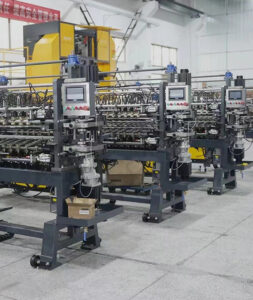Mattress production lines combine various manufacturing processes to deliver high-quality mattresses efficiently. Here’s a breakdown of key stages and the machinery involved.
1. Material Preparation
– Foam Cutting:High-density foam and other materials are precisely cut using computerized cutting machines. These machines ensure consistency across batches, optimizing material usage.
– Spring Coil Production:Mattresses with innersprings go through coil manufacturing, where automated machines create coils and then assemble them into a spring unit.
2. Layer Assembly
– Bonding and Layering:Various layers, like foam, latex, and spring units, are stacked and bonded using adhesives. Automated bonding machines apply adhesive evenly, speeding up the assembly.
– Quilting and Padding:Quilting machines add texture and reinforcement to the mattress surface, stitching fabrics with additional padding for comfort.
3. Mattress Assembly and Final Stitching
– Edge Reinforcement:Some mattresses have reinforced edges, which require specific machinery to add foam or metal borders to improve structural integrity.
– Encasing and Stitching:The final stitching process uses encasing machines to wrap the entire mattress in fabric and secure the edges with durable stitching.
4. Quality Control and Packaging
– Each mattress undergoes rigorous testing for firmness, structural stability, and comfort. Defective units are either reworked or discarded.
– Finally, packaging machines compress and seal the mattresses in vacuum-sealed bags, ready for storage or shipping.
The production line relies on advanced machinery and quality control to meet diverse demands for durability, comfort, and design.

